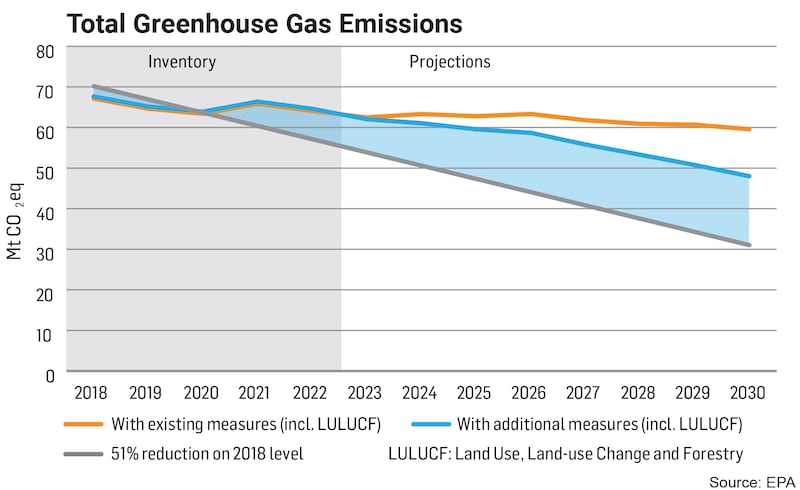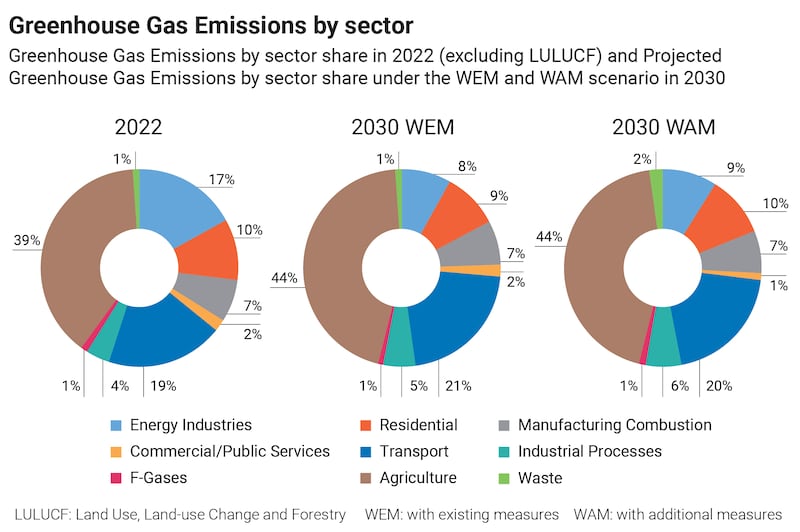Ireland is set to reduce its total greenhouse gas (GHG) emissions by only 29 per cent by 2030, compared with the legally-binding target of 51 per cent, the Environmental Protection Agency has warned in its latest projections.
The data produced annually for the EU shows a pattern of continually missed targets, when sustained emission cuts are required.
The first two legally-binding carbon budgets (covering 2021-2025, and 2026-2030) – designed to curb emissions across the economy – will not be met, the EPA concludes, “and by a significant margin of between 17 and 27 per cent”.
This will mean more stringent limits will have to be applied in the second budget period from 2026-2030, as excess GHG emissions from the preceding budget period must be carried forward to the next period. This risks the State having to curb economic activities with higher associated carbon, such as in industry or agriculture.
READ MORE
There are also sizeable compliance costs looming due to a likely failure by the Government to meet its EU “effort-sharing regulation” target of a 42 per cent cut by 2030. These are estimated at between €3 billion and €8 billion depending on carbon price and “flexibilities” that the EU may grant. Substantial EU fines can be applied separately for emissions failures in industry and energy sectors.
The EPA concludes in analysis published on Tuesday that even with full implementation of measures in the Government’s 2024 climate plan, the most that may be achieved is short of 30 per cent. This is a best-case scenario by factoring in “with additional measures”, which are the latest Government plans but which have yet to receive funding or legislative backing.
To achieve that level of decarbonisation “would require full implementation of a wide range of policies and plans across all sectors and for these to deliver the anticipated carbon savings”, it adds.
Almost all sectors are on a trajectory to exceed their sectoral emissions ceilings for 2025 and 2030, notably agriculture, electricity and transport. Power generation using renewables such as wind and solar is closest to target.
EPA modelling shows planned climate policies and measures, if fully implemented, will only lead to a reduction of 4 per cent each year from 2023 to 2030 – far short of the commitment to halve emissions.
All sectors, except residential and commercial buildings, are projected to underperform relative to ceilings. Agriculture, industry and land use sectors are projected to be the furthest away – due to excess GHGs – while electricity is closest to target.
EPA director general Laura Burke said: “Full delivery of all climate action plans and policies could deliver a 29 per cent reduction in greenhouse gas emissions. This is well short of both our European and national emission reduction targets and highlights the scale of effort required to achieve the required reductions across all sectors of our economy. The key priority must be to translate the aspiration in our policies and plans to implementation on the ground.”
Transitioning to a low-carbon society was building momentum in Ireland, she said. “We see this with more electric vehicles on our roads, renewable electricity powering our homes and adoption of new farm practices. However, we need to speed up and scale up the transition.”
EPA programme manager Mary Frances Rochford said the projections underlined the need to accelerate delivery of “renewable technologies to support decarbonised electrification across the economy; adopting known emission reduction technologies while new solutions are developed in agriculture, providing alternatives to car and freight transport, and taking action to reduce emissions from land”.
The EPA concedes a range of announced Government measures could generate significant emissions reductions, but were not included because of insufficient detail on implementation pathways. These included commitments on scaling up onshore and offshore wind energy, expansion of solar PV and deployment of “new flexible gas-fired [power] generation”.

Meanwhile, Minister for Environment Eamon Ryan will bring a number of climate memos to Cabinet on Tuesday which have been described as “stark” and “sobering.”
Mr Ryan is due to outline the rapid rate at which the climate is deteriorating, defying predictions.
He will tell Ministers that 2023 was the warmest year overall on record, and in June an extreme marine heat wave occurred off the West coast where sea surface temperatures reached 5.5 degrees above normal, which resulted in tropical and freak rainfalls and damaging flash flooding.

Ministers will be told that for Ireland, the greatest risk is that the circulation of water flows from South to North to off the Atlantic coast, which gives Ireland its temperate climate, could weaken or collapse this century. If this protection is lost, Ireland could be looking at winter temperatures like -10 to -15 degrees, and summer temperatures no warmer than 10 degrees.
He will also bring a memo on the National Energy and Climate Plan, which focuses on the actions Ireland is taking to meet its EU 2030 targets for greenhouse gas emission reductions. It takes into account the EPA’s emissions projections. Mr Ryan will tell Cabinet that the projections “do not immediately tell the full story” as sufficient data is not yet available to allow all actions in our Climate Action Plan to be modelled.
- Sign up for push alerts and have the best news, analysis and comment delivered directly to your phone
- Join The Irish Times on WhatsApp and stay up to date
- Listen to our Inside Politics podcast for the best political chat and analysis













